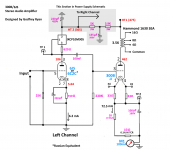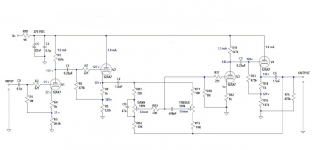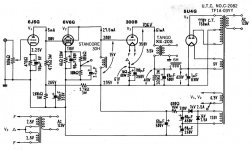You should do some simulation of your circuit (personally, I hate software and software simulators).
Why?
You have 3 poles in the cathode / cathode / filament circuits. And you have 3 poles in the grid circuits.
Depending on the Gain /Phase, you might end up with a low frequency oscillation.
And, as was asked earlier, what was the 300B amplifier that you liked the sound of?
Did it have negative feedback?
What was the loudspeaker that it was connected to?
Duplicating a particular sound that you like, is not always as simple as you think.
I never used negative feedback in my SE 300B amplifiers; and I never used negative feedback in my Push Pull 300B amplifiers.
Just my opinions.
Why?
You have 3 poles in the cathode / cathode / filament circuits. And you have 3 poles in the grid circuits.
Depending on the Gain /Phase, you might end up with a low frequency oscillation.
And, as was asked earlier, what was the 300B amplifier that you liked the sound of?
Did it have negative feedback?
What was the loudspeaker that it was connected to?
Duplicating a particular sound that you like, is not always as simple as you think.
I never used negative feedback in my SE 300B amplifiers; and I never used negative feedback in my Push Pull 300B amplifiers.
Just my opinions.
Last edited:
The schematic posted at message #1 is a Shishido design according to JC Morrison and it has been used by Sun Audio for both their 2A3 and 300B amplifiers since the 1980s and, as far as I know, is a current product you can buy as a kit.
JCM included the schematic as one of a couple dozen in a pamphlet of mostly Japanese designs he published about 1995. Someone has exploited JCM's name to draw attention to this schematic and that means some falsely believe that since it was published by him (as well as Sun Audio), that is an endorsement, when actually it was intended to show what others had done and be an avenue for exploration.
OK, that said, if you want to build a more modern design, the high Gm pentodes, when triode connected, can drive a 300B to full output (something the Sun Audio can't do) with about 1V input sensitivity. This assumes a DAC or CD player with 2Vrms output and a volume control at the input. The EC86 was already been mentioned as is a great tube capable of driving the 300B to full output and is an inexpensive and reliable triode. I use it in my 2A3 amp and use the EC8010 which is more expensive and difficult to find in my 300B amp.
JCM included the schematic as one of a couple dozen in a pamphlet of mostly Japanese designs he published about 1995. Someone has exploited JCM's name to draw attention to this schematic and that means some falsely believe that since it was published by him (as well as Sun Audio), that is an endorsement, when actually it was intended to show what others had done and be an avenue for exploration.
OK, that said, if you want to build a more modern design, the high Gm pentodes, when triode connected, can drive a 300B to full output (something the Sun Audio can't do) with about 1V input sensitivity. This assumes a DAC or CD player with 2Vrms output and a volume control at the input. The EC86 was already been mentioned as is a great tube capable of driving the 300B to full output and is an inexpensive and reliable triode. I use it in my 2A3 amp and use the EC8010 which is more expensive and difficult to find in my 300B amp.
Thanks for the responses everyone.
Sounds like a no go so I will keep fiddling and come up with a no feedback design. I have a bunch of 6BM8's and would like to use them if possible.
The basic circuit sims pretty well even without the GFB loop but is probably too sensitive, needing only 0.1- 0.2V for full output.
6A3summer I hear your comments on the simulators but it's just a first step before I invest big dollars in some transformers.
Thanks All.
Sounds like a no go so I will keep fiddling and come up with a no feedback design. I have a bunch of 6BM8's and would like to use them if possible.
The basic circuit sims pretty well even without the GFB loop but is probably too sensitive, needing only 0.1- 0.2V for full output.
6A3summer I hear your comments on the simulators but it's just a first step before I invest big dollars in some transformers.
Thanks All.
I just went through this trying that "sun audio", or whatever people want to call it, design. I ended up using a cascode with 6SN7 tubes and it turned out nice. That other design just doesn't have what it takes to drive a 300B grid. I also agree, you don't need NFB to get low distortion out of a SET and it will ruin the sound. And I agree with 6A3summer about spending a bunch of time simulating this. People kept sending me simulations that they swore would "fix that design" and none of them did.
300B Tube Amp: Final Analysis, Mods and Solutions for JC Morrison based Amplifiers. - YouTube
I have another playlist on building a budget 300B amp that sounds great using Edcor 5K OT.
300B DIY Budget Tube Amplifier Build Series - YouTube
300B Tube Amp: Final Analysis, Mods and Solutions for JC Morrison based Amplifiers. - YouTube
I have another playlist on building a budget 300B amp that sounds great using Edcor 5K OT.
300B DIY Budget Tube Amplifier Build Series - YouTube
you don't need NFB to get low distortion out of a SET and it will ruin the sound.
I totally agree. I tried GNF on my 300B/6SN7 amp, and it sounded nothing like a tube amp - it was more like one of my Quad 405 solid state amps.
Why not try this one. It's a modification of a previous design I did. It uses a resistor instead of a IXCP10M90S CCS. (Much safer if you are using expensive 300Bs) You might need to change the 300B's Cathode resistor, depending on tubes used. Disregard the 72.5 mA - that was what I set the CCS to in the original design. It needs about 3 Volts RMS input for full power output, so a good pre-amp will be necessary. You might need to experiment a bit, but it might give you ideas.
Attachments
Last edited:
How can a 6J5 (mu = 20) drive a 300B to full power all by itself?
Let's say you get all of the 6J5's gain, so 20X (just for the thought experiment).
Let's say you run the 300B with a grid bias of -70V (or +70V at the cathode for cathode bias).
In order to get 70V peak at the 300B grid, you'll need 3.5V peak signal at the grid of the 6J5 (3.5V*20 = 70V).
For most systems, you'll need to add another gain stage in front of this design, which ends up being basically the same thing as the Sun Audio circuit in post #1.
Someone else mentioned a C3a-triode as the voltage amp/driver stage for a 300B. That's basically the same as what you have here, but with a C3a-triode instead of the 6J5. That would work because the mu of a C3a-triode is high (although I don't know exactly what it is because I can't find a C3a data sheet). FWIW, mu of a triode wired D3a is listed as 80. You could probably get 50X gain out of one, which means it could drive the 300B to full power with about 1.5V peak input signal (1.5V*50 = 75V).
--
3.5V Peak is 2.475V RMS. Perfectly doable here, easily within the capability of a good pre-amp.
A good preamp is exactly what the first stage is in the circuit shown in post #1.
I don't see many power amps with a selector switch or tone and balance controls.
Why not?
What's wrong with a pre-amp anyway? Sometimes, I drive mine from a small solid-state Behringer mixer, but right now I use a tube pre-amp - buckets of drive.
Last edited:
What's wrong with a pre-amp anyway.
There are literally dozens of threads on that topic.
Let's look at an example.
If you're using a DAC as your audio signal source, it will have a max output of 2.83V peak (2V rms) audio signal.
Let's say we have a power amp that needs 3V rms input signal to be driven to full power output.
Let's say we want 6dB of extra gain to compensate for unusually quiet sources, such as the odd weirdly mastered CD or maybe a mobile phone that only outputs 1V rms max audio signal.
The gain we need to bring that 1V rms signal up to 3V rms is only 3X (10dB).
With CD players and DACs, the gain we need is half of that, or 1.5X (3.5dB).
Let's say we're OK with a bit of extra gain, and we decide on a target gain of 5X for our preamp (14dB). How do we make a line preamp with 5X gain? And since this is a preamp for a 300B amp, let's say we must have a 'pure tube' 'zero negative feedback' circuit too.
Remember that our preamp will need to be able to drive whatever interconnect cables we have running from it to the power amp. Let's say that cable will have capacitance of 500pF (0.5nF). We'll probably want to have that preamp be able to sink 3mA current minimum into the load. Maybe 5mA. Sure, why not?
A bypassed cathode 6SN7 or 6J5 common cathode stage will have roughly 15X gain with output impedance of roughly 10k ohms.
1V peak * 15 = 15V peak or roughly 10V rms.
The extra (and unnecessary) gain will come with a noise penalty. Unavoidable noise like 1/f, shot, thermal, etc. noise from the preamp will be higher in level if that preamp has more gain. It might be OK, though. Some folks are fine with a little bit of background hiss. Hum is a different problem, but that can be dealt with using DC heater supplies, careful layout, regulated B+, etc.
To compensate for the extra gain on tap, you'll be listening with the volume control set pretty low, all the time. That's fine, but it might be a bit twitchy and easy to overload the amp on program peaks.
Let's look at what we can do for a triode with lower gain.
There's a thread about using a 12B4A triode as a line stage, and another one using a triode wired 6V6 as a line stage.
The 12B4A would be just about perfect in this particular situation because it will have gain of right around 5X.
A 6V6-triode will have gain of around 8X, or about half that of a 6J5/6SN7.
A line stage with gain any lower than that will probably require negative feedback (( 😱 )). I was thinking a 6DJ8 (ECC83) anode follower incorporating a MOSFET source follower/output buffer might work well. That way I can dial in the exact gain I want by adjusting the negative feedback voltage divider resistor values.
Or, of course, one could just build a selector switch, volume control and balance control into the power amp, call it an integrated amp, and be happy.
My whole point is that we've come this far into the thread and we're still talking about little variations on the circuit displayed in post #1. This suggests to me that the circuit in post #1 is probably good enough to try to optimize.
So the circuit we have in post #1 is a 3-stage circuit (like Herb Reichert's "Flesh and Blood" amp in Sound Practices), using a 6SN7 cascade to the 300B (with OPT). There are other circuits that could be proposed.
1) A two-stage circuit using high-mu, high-gm pentode-wired-triode as the voltage amp/driver RC-coupled to the 300B (with OPT).
2) Use a high-mu triode like 6SL7 or 12AX7 (ECC83) to supply the necessary voltage gain, followed by a source follower or cathode follower to supply the current gain and low impedance for driving the 300B.
6SL7 can be used with a large value plate resistor or CCS in the plate to yield 50X or more gain, which should be enough. A 6SN7 or 6N6P could be used for the cathode follower, or a low Crss MOSFET (like ZVN0545 or FQP2N60) could be used as a source follower.
3) Since this is a 300B amp, and presumably price is no object, one could use a plate choke-loaded power triode (low mu) to drive the 300B, with a 6J5 or 6SN7 as the input voltage amp. Noryasu Komoru built a 3-stage all DC-coupled 300B amp using 6J5 > 6V6-triode with plate choke > 300B that I heard. It was a beautiful sounding amp.
4) or of course one could use an interstage transformer between the driver stage and 300B. That would cost real money.
So many possibilities.
However, the one in post #1 can be made well. Why not?
Last edited:
What's wrong with a pre-amp anyway? Sometimes, I drive mine from a small solid-state Behringer mixer, but right now I use a tube pre-amp - buckets of drive.
Here is a fine tube pre-amp that I built from a kit.
Link.
Attachments
However, the one in post #1 can be made well.
Have you ever built or worked on an amp based on that design? Not run on a sim, but actually built one? You will barely get over 1W at reasonable THD and anything over that has some nasty distortion of the signal into the grid of the 300B.
It's a shame that schematic has become so famous as a "Go to" 300B design.
@rangon
GregH2 was looking for ideas, and he said he would consider other designs. That's what I gave him - simple as that.
GregH2 was looking for ideas, and he said he would consider other designs. That's what I gave him - simple as that.
Have you ever built or worked on an amp based on that design? Not run on a sim, but actually built one? You will barely get over 1W at reasonable THD and anything over that has some nasty distortion of the signal into the grid of the 300B.
It's a shame that schematic has become so famous as a "Go to" 300B design.
I meant as a topology to work from (see Palustris' post earlier in this thread).
Also see Herb Reichert's "Flesh and Blood" amp, which is basically similar to the circuit in post #1, but was built in real life (I heard it back in the 1990s). The Flesh & Blood wasn't great (IMO), but it worked.
I did not mean that exact circuit. I meant that topology, that circuit 'shape'. It can be *optimized*.
Jack Elliano has a direct Coupled 300B thats been in my folder called "my first 300B" schematics for some time. Just throwing it out there because it is so simple and that multi tap resistor sure makes it easy to trim the operating point for a direct Coupled amp. Ultrapath cathode bypass. 700 V is high for a beginner like me, but I'm careful. 300B should love 700V. I have a One Electron OPT waiting to be used, but Id order the 60H chokes from Jack. Then later get some OPT's from Jack as well. I think DRD is Jacks abbreviation for "Direct Reactance Drive".
Electra-Print.com 300B DRD Audio Tube Amplifier
Electra-Print.com 300B DRD Audio Tube Amplifier
Last edited:
Jack Elliano has a direct Coupled 300B thats been in my folder called "my first 300B" schematics for some time. Just throwing it out there because it is so simple and that multi tap resistor sure makes it easy to trim the operating point for a direct Coupled amp. Ultrapath cathode bypass. 700 V is high for a beginner like me, but I'm careful. 300B should love 700V. I have a One Electron waiting to be used, but Id order the 60H chokes from Jack. Then later get some OPT's from Jack as well.
Electra-Print.com 300B DRD Audio Tube Amplifier
I like it, especially that it uses just one tube in the driver stage. But the 6AN4 has a very high mu, of course (70).
Last edited:
Kind of a Loftin-White idea using a high-gm, high-mu RF triode (low-ish rp too). Could be good!
Since we're now in DC-coupled territory, I'll throw this one in, because I heard it in person (at the old Fi store on Watts St in NYC, back around 1990) and it sounded really good at the time. I'm not saying it's the be-all-and-end-all of SE 300B circuits. But it was built in the real world and it did sound very good indeed (I remember Bill Evans "Waltz for Debby" playing through it. The audience noise in the Village Vanguard had a 'you are there' feeling.)
Since we're now in DC-coupled territory, I'll throw this one in, because I heard it in person (at the old Fi store on Watts St in NYC, back around 1990) and it sounded really good at the time. I'm not saying it's the be-all-and-end-all of SE 300B circuits. But it was built in the real world and it did sound very good indeed (I remember Bill Evans "Waltz for Debby" playing through it. The audience noise in the Village Vanguard had a 'you are there' feeling.)
Attachments
Last edited:
- Home
- Amplifiers
- Tubes / Valves
- Advice for first SET amp build


